The Science of Reading: Overcoming Reading Difficulties
How do children learn to read? The science of reading dives into the process of learning to read, and pinpoints why reading difficulties develop. It has gained an increasingly large following as more and more research studies continue to back it up.
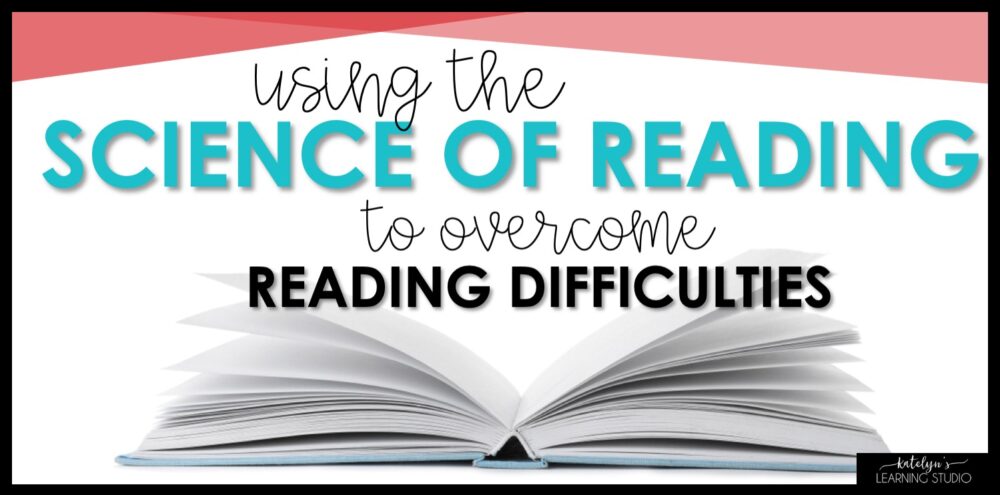
If you’ve wondered, “What is the science of reading?” this post is for you!
What is the Science of Reading?
The science of reading is just that–the science of how the brain learns to read. It’s not a theory, program, or idea. It is simply the “behind the scenes process” of how we become good readers. It has been researched now for decades, and researchers have found an incredible amount of evidence to support this process.
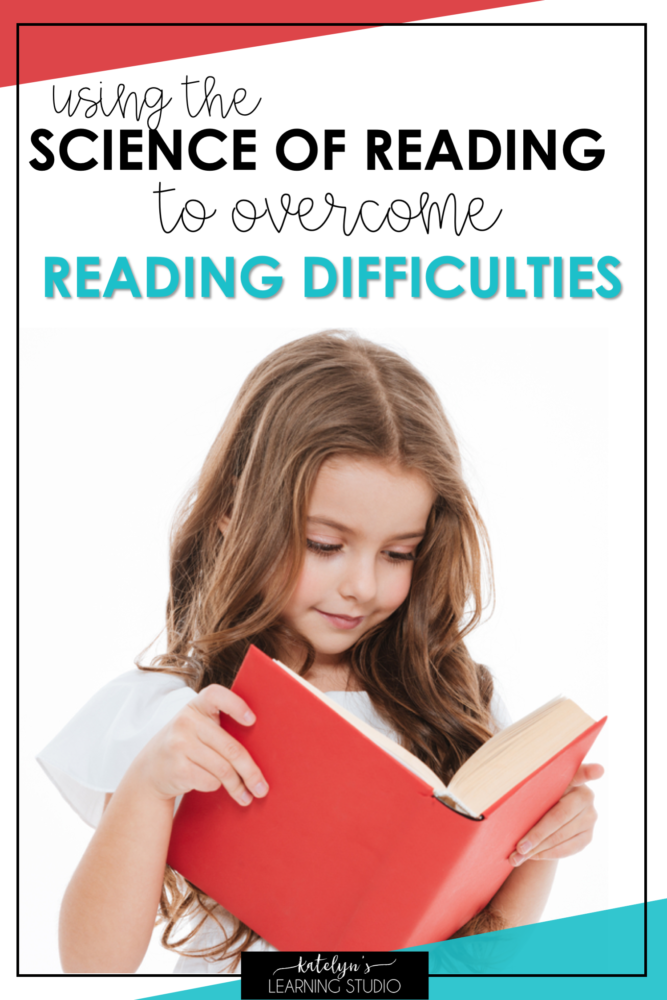
Understanding the science of reading gives us greater power in helping our students overcome reading difficulties.
So…
How DO Kids Learn to Read?
Learning to read starts before letters are even introduced. It all starts with the most basic unit of speech–phonemes. Before students are able to read, they need to be able to HEAR the sounds in words and understand that words are made up of little units of sound put together. This first step is called Phonemic Awareness (you can read more about what phonemic awareness is here).
The Science of Reading and Phonemic Awareness
In the science of reading, there is a heavy emphasis on phonemic awareness–all the way up to the advanced level. Students need to not only hear and blend sounds together, but they also need to be able to manipulate them. This means:
- adding sounds in words
- subtracting sounds in words
- substituting sounds in words
The stronger their phonemic awareness skills, the stronger the foundation they have to read.
In fact, according to the National Reading Panel, phonemic awareness (under the umbrella of phonological awareness) in kindergarten is the number one predictor of reading success in later years!
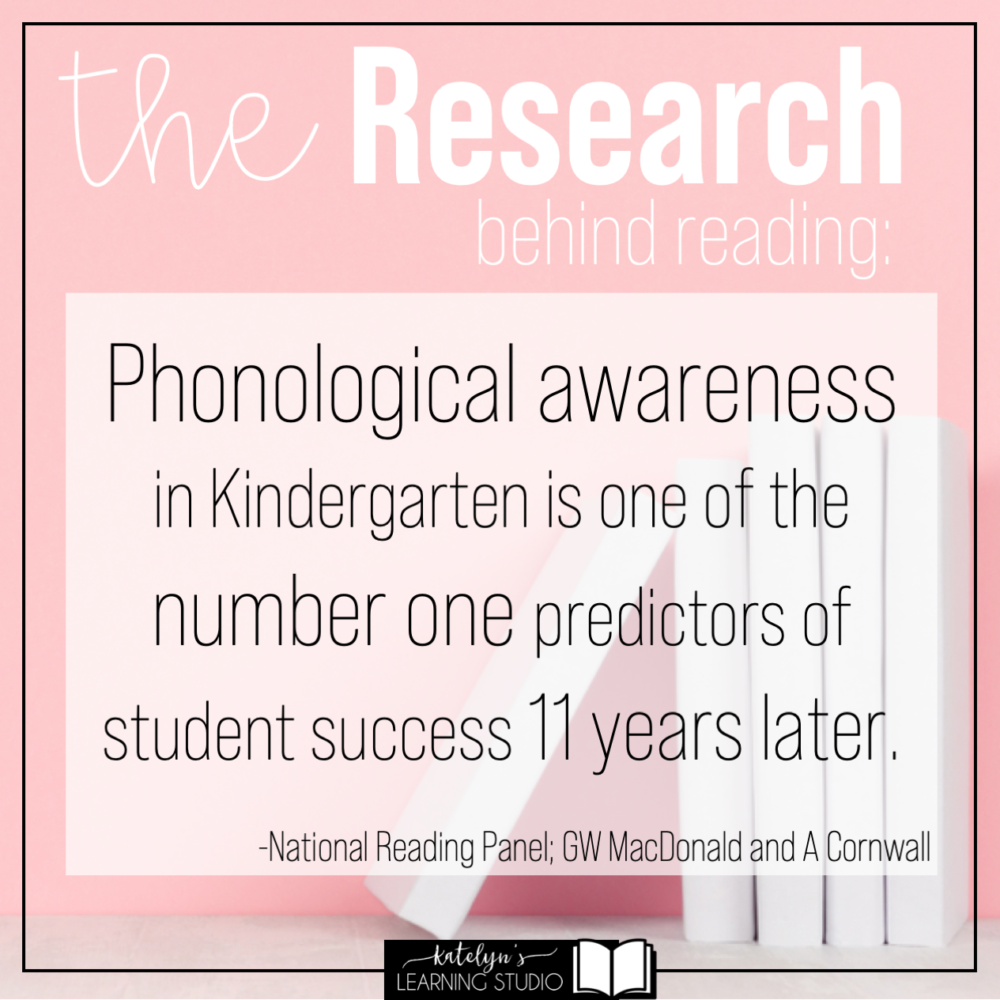
Why is phonological awareness important? It is the number one predictor of success!
Connecting Phonemic Awareness and Phonics
In addition to a focus on phonemic awareness, the science of reading emphasizes strong letter knowledge and phonics skills.
And then, the key part here, the science of reading uses the secret weapon of CONNECTING the sounds they hear (phonemic awareness) to the letters they see (phonics). Connecting phonemic awareness to phonics helps facilitate orthographic mapping–which is how the brain turns new words into instantly recognizable sight words.
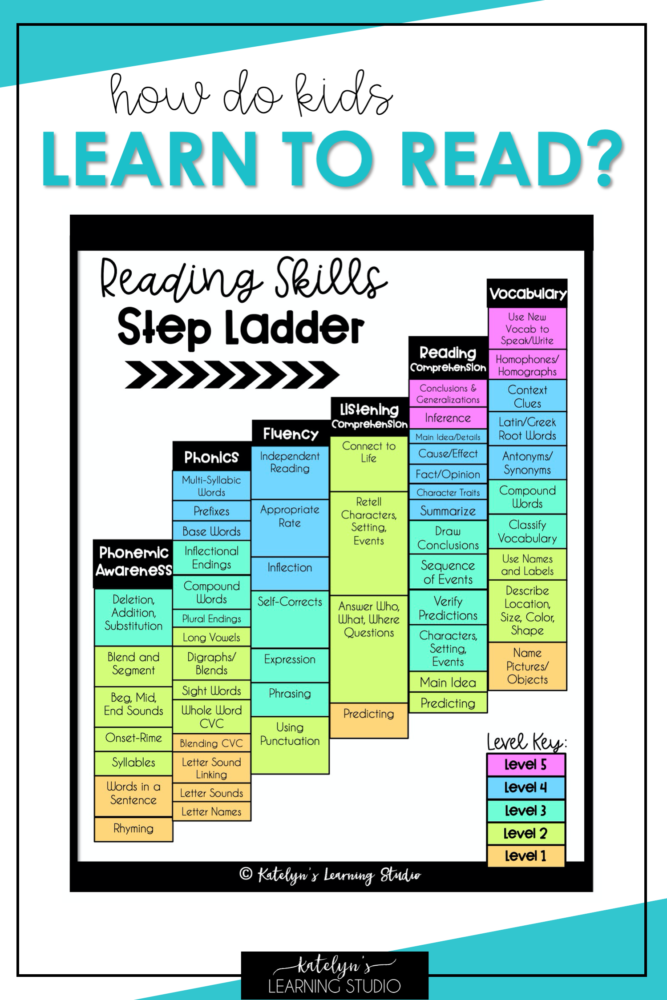
Here is a chart that aligns great with the science of reading and shows how reading skills are gained. Download it for FREE here!
You can download my FREE Reading Skills Step Ladder for an easy “at-a-glance” reference. It shows the sequence that skills are learned in each of the Big 5 Reading Skills, as well as emphasizes how phonemic awareness + phonics leads to fluency and comprehension.
How was the Science of Reading developed?
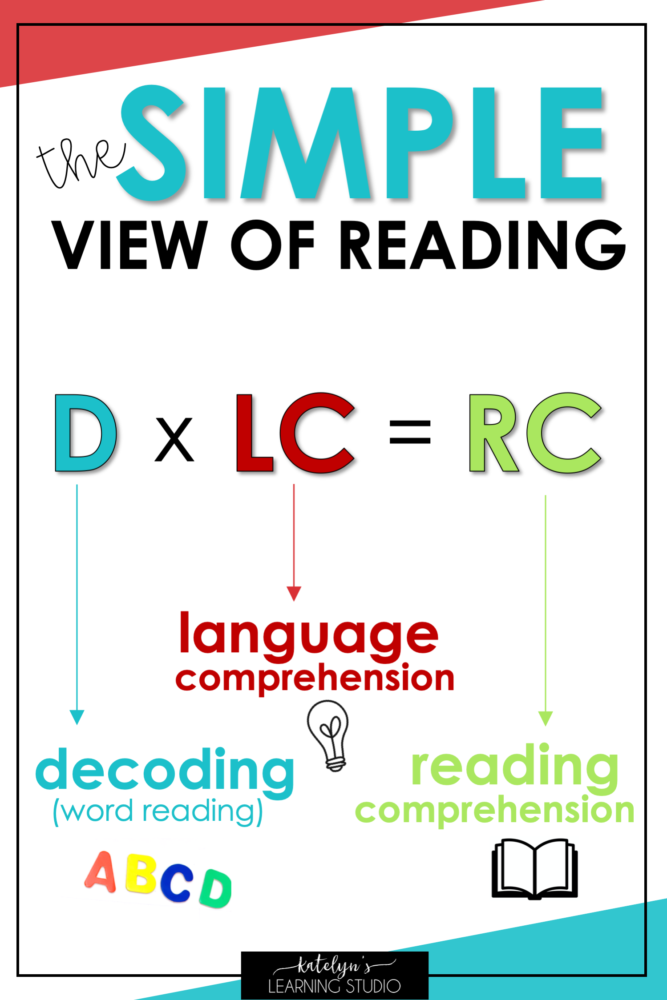
The simple view of reading explains how decoding and language comprehension are inter-connected to promote reading comprehension.
The Simple View of Reading by Gough and Tunmer 1986
What is the simple view of reading? The science of reading draws heavily on a simple formula Philip Gough and William Tunmer created in 1986 as a way to explain what leads to proficient reading. That formula is:
Decoding x Language Comprehension = Reading Comprehension
D x LC = RC
Notice that multiplication symbol in there? That’s important!
You cannot have proficient reading comprehension if EITHER word reading or language comprehension is at a zero. You need both to really comprehend what you read.
So we have two important aspects of learning to read:
- Decoding (word reading)
- Language Comprehension
The Science of Reading Chart
Within those two larger skills categories of word reading and language comprehension, Hollis Scarborough created a fantastic visual showing all of the different strands that make up each part of word reading and language comprehension, and then how those strands work together to create a strong reader.
Scarborough’s Reading Rope
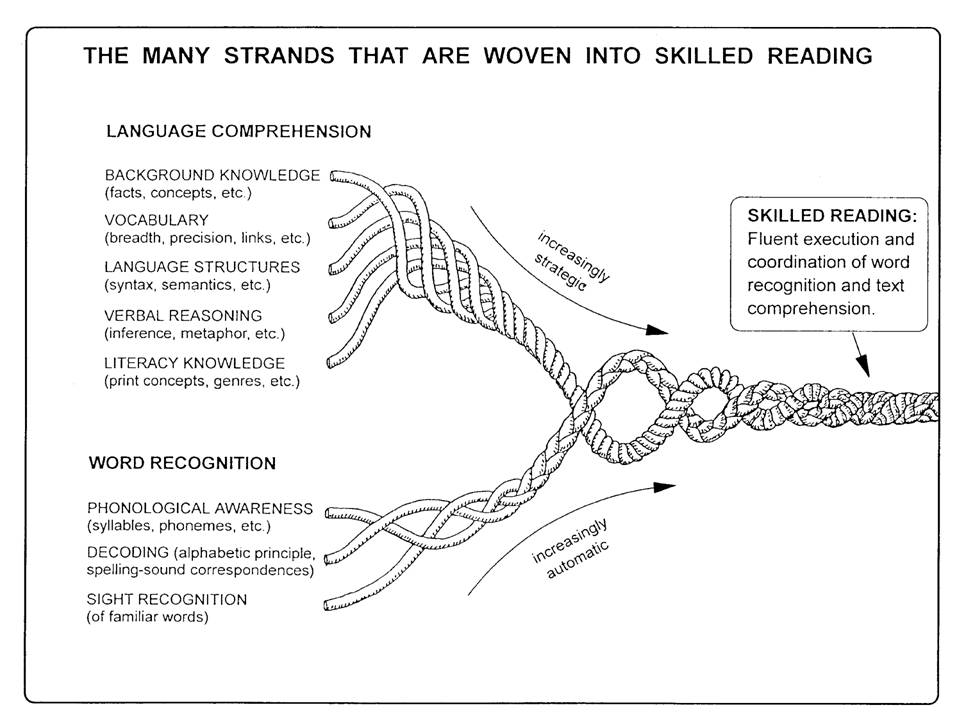
Scarboroughs Reading Rope shows us all of the different strands that make up skilled reading. (image from International Dyslexia Association, originally appeared in the following publication: Scarborough, H. S. (2001). Connecting early language and literacy to later reading (dis)abilities: Evidence, theory, and practice. In S. Neuman & D. Dickinson (Eds.), Handbook for research in early literacy (pp. 97–110). New York, NY: Guilford Press.)
This visual aligns beautifully with the Simple View of Reading, with Langage Comprehension (LC) being the top threads, and Word Reading (D) being the bottom threads. They are both knit together to affect Reading Comprehension, or skilled reading.
Notice that for word reading (which is what most of your struggling readers will need help with) the three main areas to focus on are phonemic awareness, decoding (phonics/word reading), and sight recognition. Here is some more information on each of those:
- What is Phonemic Awareness?
- 8 Intervention Strategies for Phonemic Awareness
- What is Phonics?
- How to teach Phonics Step by Step
- 13 Phonics Strategies You Need to Try
- Orthographic Mapping and Sight Recognition

These science of reading books are great for going in-depth on how kids learn to read and how to help them.
Science of Reading Books for Professional Development
There are SO many great resources out there that work as great professional development to teach the science of reading. These five books are some of the best that dive deep into the science of reading research. (affiliate links, but I highly recommend them!)
- Essentials of Assessing, Preventing, and Overcoming Reading Difficulties by David Kilpatrick
- Speech to Print by Louisa Cook Moats
- Language at the Speed of Sight by Mark Seidenberg
- Reading in the Brain: The New Science of How We Read by Stanislas Dehaene
- Phonics from A to Z by Wiley Blevins
David Kilpatrick’s book is AMAZING and thorough and I highly recommend reading it. He gives amazing insight and backs EVERY claim he makes with specific and extensive research. It is lengthy, but really worth it if you want to back up your interventions with researched rationale.
Science of Reading: Overcoming Reading Difficulties
The Simple View of Reading can help identify reading problems. We know that the science of reading teaches us two essential components of reading: word reading and language comprehension. We know that when one of those areas suffers, reading comprehension also suffers. So what happens to make either word reading or language comprehension suffer?
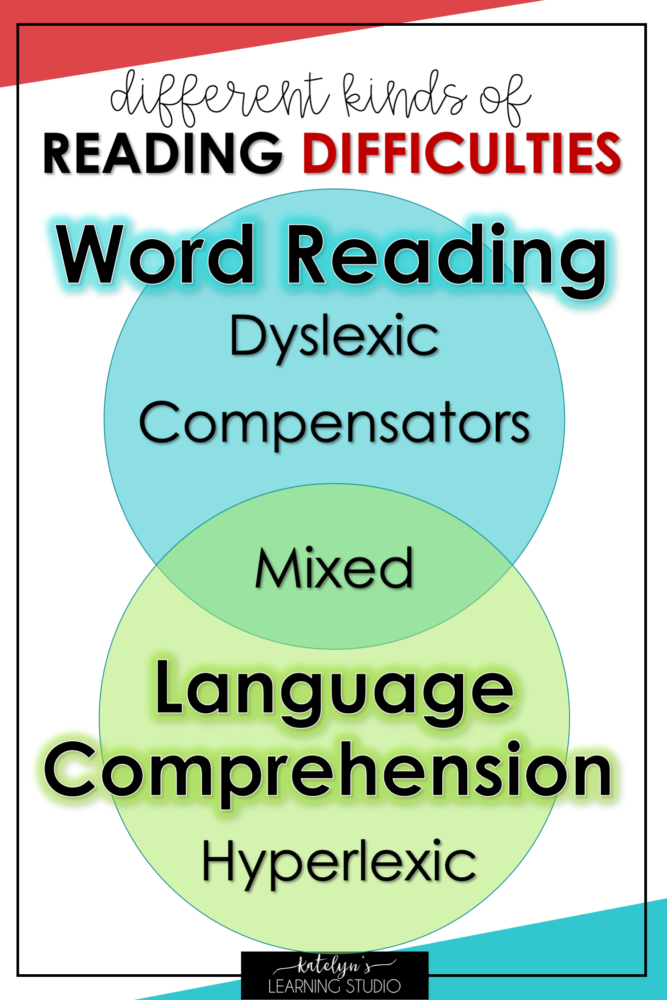
Types of reading difficulties stem from either word reading or language comprehension.
Types of Reading Difficulties
Poor reading is caused by problems in decoding, language, or both. There are 4 different types of reading difficulties that help address these different problems in reading.
- Dyslexia
- Hyperlexia
- Mixed
- Compensators
1. Dyslexia: Problems with Word Reading
Dyslexia is the most common cause of word reading difficulties and is different than most people think. It is not a visual impairment but rather is caused by a phonological core deficit (meaning students have trouble hearing, identifying, and manipulating sounds in words).
Dyslexia reading examples:
- Younger students might have an especially hard time connecting sounds to written letters.
- A student with dyslexia will struggle to decode, or sound out words. They might be able to say the sound of each letter out loud, but have a hard time connecting the sounds to make a word.
- Dyslexic students will read very slowly and laboriously because they need to struggle through decoding almost every word. This is because they have not been able to store sight words through orthographic mapping (because of their phonological core deficit).
*For more information on dyslexia, visit the Yale Center for Dyslexia and Creativity or the International Dyslexia Association websites.
2. Hyperlexia: Problems with Language Comprehension
Hyperlexic students struggle with language comprehension. They can actually decode fairly well, and may even sound like they are reading fluently. However, if you ask them about what they just read, they will struggle to tell you about it. They might miss main ideas or key details, struggle to summarize, or even struggle to understand each word as they read it. They can basically go into robot reading mode and pump out a passage super fluently like a machine, but have no idea what they just read.
3. Mixed: Problems with Word Reading AND Language Comprehension
Students with mixed reading difficulties struggle with both the decoding and the language side of the equation. These students have no “crutch” to lean on and usually very obviously struggle in reading.
4. Compensators: Problems with Word Reading → Disguised by Strong Language Skills
This type of reading difficulty is often the trickiest to catch. These students seem like they are getting by ok, especially in the younger grades before texts get too complex. However, as they enter into older grades they start falling farther and farther behind.
Why is this? Because all along they have struggled to decode. They have covered up their reading difficulties with advanced language skills. They are expert guessers and use context clues to figure out what words are. Reading for these kids is extremely laborious because they have to work extra hard to figure out each word they read, like solving a mystery with each word. In addition, it becomes impossible to keep up with their peers when texts get too hard for them to guess all of the words they don’t know.
The Science of Teaching Reading: What Teachers Should Know
Now that we know all about the science of reading and how kids learn to read, we need to put all of that knowledge into action. We need to dive into the science of TEACHING reading.
What is the science of teaching reading? It’s the act of using evidence based reading interventions in your teaching. It’s providing effective interventions for your struggling readers so that they can start to make progress.
What teachers should know about the science of reading:
These are the 3 key essentials that teachers should know about the Science of Reading.
- The Progression of Reading Skills– teachers need to have an understanding of how reading is learned and in what order to teach different skills (here is a FREE Reading Skills Step Ladder to help with that).
- The Different Types of Reading Difficulties– teachers need to know the characteristics of each type and learn how to identify them in their own students (as explained above).
- The Reading Intervention Path– teachers need to know what actions they should take for each type of struggling reader–explained below.

This cycle helps you know how to help struggling readers.
The 4 Steps in Reading Intervention: How to help struggling readers with the Reading Intervention Path
The reading intervention path, or as I like to call it–“The Difference Maker Cycle,” shows how intervention is a cycle and there is constant re-aligning to student needs.
These are the 4 steps in Reading Intervention:
- Use accurate assessments to IDENTIFY and pinpoint exactly what area your student is struggling in.
- Make a PLAN for how to bridge the gap (hint: follow this reading step ladder as a guide).
- TEACH using research based reading interventions to address exactly the areas your student needs help in.
- Provide continuous progress monitoring to see if you need to ADJUST your teaching.
You keep moving through the cycle to identify and meet student needs, and then monitor their progress. This is also called RTI in reading–“Response to Intervention.”
How do you choose reading intervention programs that align with the Science of Reading?
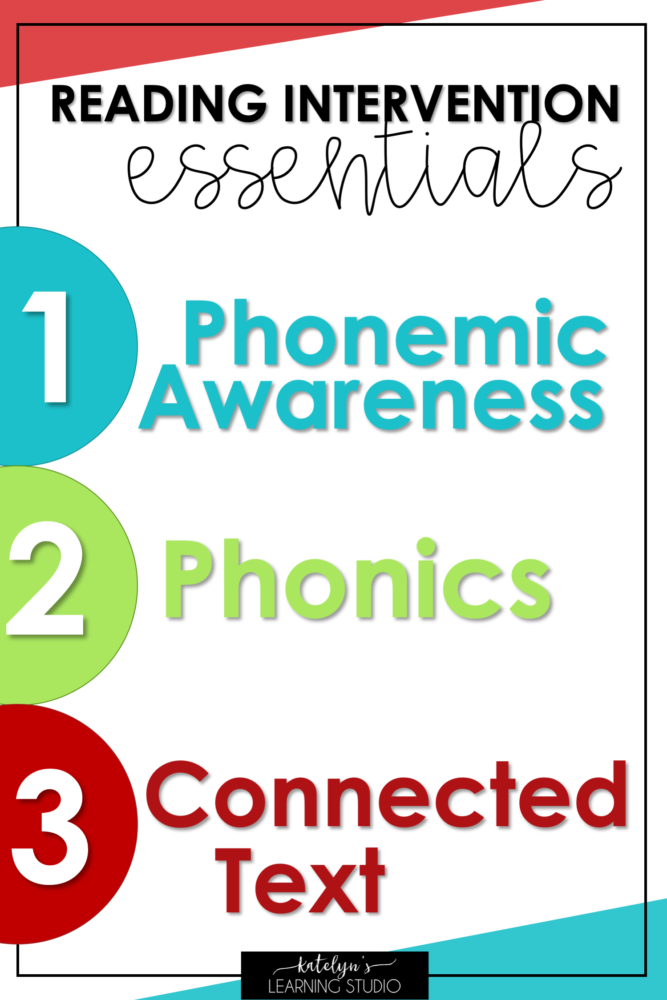
Reading programs for struggling readers should have these three essential components.
Reading programs for struggling readers should have these 3 elements:
- Strong emphasis on phonemic awareness skills (all the way up to the advanced level–see this post on what phonemic awareness is)
- Explicit and systematic phonics instruction (see how to teach phonics step by step!)
- Plenty of opportunities to read connected text (multiple sentences strung together to tell a story or give coherent information)
Many studies have shown that these three elements make the biggest impact on student growth and reading proficiency.
*When setting up your reading intervention program, here are 6 must-haves to make it successful!
MTSS in Education: RTI
The best way to deliver effective interventions for struggling readers is by using a Multi-Tired System of Support (MTSS), often including the Response to Intervention (RTI) 3 tiers.
RTI Tiers:
- First, deliver a universal screening to identify all potential struggling students as soon as possible.
- Then, provide research-based whole-class instruction to prevent as many reading difficulties as possible in the first tier.
- If students are still struggling, you can administer additional small group intervention sessions in the second tier, customized by the skill they need to work on.
- Finally, after progress monitoring and collecting evidence, if the student still needs to be caught up you can proceed to the third tier. Here you pull students out for intensive one-on-one intervention targeted specifically to what that student needs.
Here are some helpful ideas for implementing interventions in the classroom, as well as a reading intervention list of tips to make your life easier!
As the knowledge of the science of reading spreads, more and more teachers and schools are adopting researched based instruction strategies and making a huge difference in helping our struggling readers. Hopefully, this information can reach teachers and help students everywhere!
